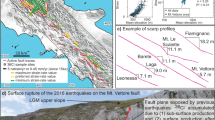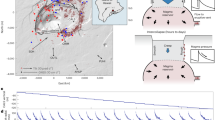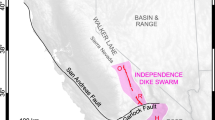Abstract
Minor changes in geometry along the length of mature strike-slip faults may act as conditional barriers to earthquake rupture, terminating some and allowing others to pass. This hypothesis remains largely untested because palaeoearthquake data that constrain spatial and temporal patterns of fault rupture are generally imprecise. Here we develop palaeoearthquake event data that encompass the last 20 major-to-great earthquakes along approximately 320 km of the Alpine Fault in New Zealand with sufficient temporal resolution and spatial coverage to reveal along-strike patterns of rupture extent. The palaeoearthquake record shows that earthquake terminations tend to cluster in time near minor along-strike changes in geometry. These terminations limit the length to which rupture can grow and produce two modes of earthquake behaviour characterized by phases of major (Mw 7–8) and great (Mw > 8) earthquakes. Physics-based simulations of seismic cycles closely resemble our observations when parameterized with realistic fault geometry. Switching between the rupture modes emerges due to heterogeneous stress states that evolve over multiple seismic cycles in response to along-strike differences in geometry. These geometric complexities exert a first-order control on rupture behaviour that is not currently accounted for in fault-source models for seismic hazard.
This is a preview of subscription content, access via your institution
Access options
Access Nature and 54 other Nature Portfolio journals
Get Nature+, our best-value online-access subscription
$29.99 / 30 days
cancel any time
Subscribe to this journal
Receive 12 print issues and online access
$259.00 per year
only $21.58 per issue
Buy this article
- Purchase on Springer Link
- Instant access to full article PDF
Prices may be subject to local taxes which are calculated during checkout




Similar content being viewed by others
Data availability
Core sedimentological (bulk density, grain size and geochemistry) and geochronological data (radiocarbon dates and age-model-derived EES age PDFs) generated during the study are available in a Figshare repository (https://figshare.com/projects/Geometry_controls_spatiotemporal_clustering_of_great_earthquakes_on_a_transform_fault/97906) or by request to the corresponding author. The synthetic earthquake catalogues for events Mw ≥ 6 produced by the 33 kyr and 100 kyr RSQSim simulations are also available from the Figshare repository. Source data are provided with this paper.
Code availability
The open source software package OxCal used to the generate earthquake chronologies is available for download or online use from https://c14.arch.ox.ac.uk/oxcal.html. The OxCal codes used to produce the age-depth models for the lakes are available in the Figshare repository (https://figshare.com/projects/Geometry_controls_spatiotemporal_clustering_of_great_earthquakes_on_a_transform_fault/97906). The source code for the RSQSim earthquake simulator is available from the authors upon request.
References
Bouchon, M. et al. Faulting characteristics of supershear earthquakes. Tectonophysics 493, 244–253 (2010).
Song, S. G., Beroza, G. C. & Segall, P. A unified source model for the 1906 San Francisco earthquake. Bull. Seismol. Soc. Am. 98, 823–831 (2008).
Robinson, D. P., Das, S. & Searle, M. P. Earthquake fault superhighways. Tectonophysics 493, 236–243 (2010).
Wesnousky, S. G. Predicting the endpoints of earthquake ruptures. Nature 444, 358–360 (2006).
Biasi, G. P. & Wesnousky, S. G. Steps and gaps in ground ruptures: empirical bounds on rupture propagation. Bull. Seismol. Soc. Am. 106, 1110–1124 (2016).
Elliott, A. J., Oskin, M. E., Liu-Zeng, J. & Shao, Y. Rupture termination at restraining bends: the last great earthquake on the Altyn Tagh fault. Geophys. Res. Lett. 42, 2164–2170 (2015).
Elliott, A. J., Oskin, M. E., Liu-zeng, J. & Shao, Y. X. Persistent rupture terminations at a restraining bend from slip rates on the eastern Altyn Tagh fault. Tectonophysics 733, 57–72 (2018).
Lozos, J. C., Oglesby, D. D., Duan, B. & Wesnousky, S. G. The effects of double fault bends on rupture propagation: a geometrical parameter study. Bull. Seismol. Soc. Am. 101, 385–398 (2011).
Biasi, G. P. & Wesnousky, S. G. Bends and ends of surface ruptures. Bull. Seismol. Soc. Am. 107, 2543–2560 (2017).
Duan, B. C. & Oglesby, D. D. Multicycle dynamics of nonplanar strike-slip faults. J. Geophys. Res. Solid Earth 110, B03304 (2005).
Duan, B. & Oglesby, D. D. Nonuniform prestress from prior earthquakes and the effect on dynamics of branched fault systems. J. Geophys. Res. Solid Earth 112, B05308 (2007).
Berryman, K. R. et al. Major earthquakes occur regularly on an isolated plate boundary fault. Science 336, 1690–1693 (2012).
Weldon, R., Scharer, K., Fumal, T. & Biasi, G. Wrightwood and the earthquake cycle: what a long recurrence record tells us about how faults work. GSA Today 14, 4–10 (2004).
Weldon, R. J., Fumal, T. E., Biasi, G. P. & Scharer, K. M. Past and future earthquakes on the San Andreas fault. Science 308, 966–967 (2005).
Lefevre, M., Klinger, Y., Al-Qaryouti, M., Le Béon, M. & Moumani, K. Slip deficit and temporal clustering along the Dead Sea fault from paleoseismological investigations. Sci. Rep. 8, 4511 (2018).
Klinger, Y., Etchebes, M., Tapponnier, P. & Narteau, C. Characteristic slip for five great earthquakes along the Fuyun fault in China. Nat. Geosci. 4, 389–392 (2011).
Ludwig, L. G., Akçiz, S. O., Noriega, G. R., Zielke, O. & Arrowsmith, J. R. Climate-modulated channel incision and rupture history of the San Andreas fault in the Carrizo Plain. Science 327, 1117–1119 (2010).
Zielke, O., Arrowsmith, J. R., Ludwig, L. G. & Akçiz, S. O. Slip in the 1857 and earlier large earthquakes along the Carrizo Plain, San Andreas fault. Science 327, 1119–1122 (2010).
Zielke, O., Klinger, Y. & Arrowsmith, J. R. Fault slip and earthquake recurrence along strike-slip faults—contributions of high-resolution geomorphic data. Tectonophysics 638, 43–62 (2015).
Scharer, K. Changing views of the San Andreas fault. Science 327, 1089–1090 (2010).
Barth, N. C., Boulton, C., Carpenter, B. M., Batt, G. E. & Toy, V. G. Slip localization on the southern Alpine Fault, New Zealand. Tectonics 32, 620–640 (2013).
Howarth, J. D. et al. Past large earthquakes on the Alpine Fault: paleoseismological progress and future directions. New Zeal. J. Geol. Geophys. 61, 309–328 (2018).
Barnes, P. M. Postglacial (after 20 ka) dextral slip rate of the offshore Alpine Fault, New Zealand. Geology 37, 3–6 (2009).
Norris, R. J. & Cooper, A. F. Late Quaternary slip rates and slip partitioning on the Alpine Fault, New Zealand. J. Struct. Geol. 23, 507–520 (2001).
Barth, N. C. et al. New c. 270 kyr strike-slip and uplift rates for the southern Alpine Fault and implications for the New Zealand plate boundary. J. Struct. Geol. 64, 39–52 (2014).
DeMets, C., Gordon, R. G. & Argus, D. F. Geologically current plate motions. Geophys. J. Int. 181, 1–80 (2010).
Norris, R. J. & Cooper, A. F. in A Continental Plate Boundary: Tectonics at South Island, New Zealand (eds Okaya, D., Stern, T. & Davey, F.) 157–175 (AGU, 2007).
Wallace, L. M., Beavan, J., McCaffrey, R., Berryman, K. & Denys, P. Balancing the plate motion budget in the South Island, New Zealand using GPS, geological and seismological data. Geophys. J. Int. 168, 332–352 (2007).
Howarth, J. D., Fitzsimons, S. J., Norris, R. J. & Jacobsen, G. E. Lake sediments record high intensity shaking that provides insight into the location and rupture length of large earthquakes on the Alpine Fault, New Zealand. Earth Planet. Sci. Lett. 403, 340–351 (2014).
Howarth, J. D., Fitzsimons, S. J., Norris, R. J., Langridge, R. & Vandergoes, M. J. A 2000 yr rupture history for the Alpine Fault derived from Lake Ellery, South Island, New Zealand. Geol. Soc. Am. Bull. 128, 627–643 (2016).
De Pascale, G. P. & Langridge, R. M. New on-fault evidence for a great earthquake in ad 1717, central Alpine Fault, New Zealand. Geology 40, 791–794 (2012).
Wells, A., Yetton, M. D., Duncan, R. P. & Stewart, G. H. Prehistoric dates of the most recent Alpine Fault earthquakes, New Zealand. Geology 27, 995–998 (1999).
Howarth, J. D., Fitzsimons, S. J., Norris, R. J. & Jacobsen, G. E. Lake sediments record cycles of sediment flux driven by large earthquakes on the Alpine Fault, New Zealand. Geology 40, 1091–1094 (2012).
Hovius, N. et al. Prolonged seismically induced erosion and the mass balance of a large earthquake. Earth Planet. Sci. Lett. 304, 347–355 (2011).
Howarth, J. D., Fitzsimons, S. J., Jacobsen, G. E., Vandergoes, M. J. & Norris, R. J. Identifying a reliable target fraction for radiocarbon dating sedimentary records from lakes. Quat. Geochronol. 17, 68–80 (2013).
De Pascale, G. P., Quigley, M. C. & Davies, T. R. H. Lidar reveals uniform Alpine Fault offsets and bimodal plate boundary rupture behavior, New Zealand. Geology 42, 411–414 (2014).
Cochran, U. A. et al. A plate boundary earthquake record from a wetland adjacent to the Alpine Fault in New Zealand refines hazard estimates. Earth Planet. Sci. Lett. 464, 175–188 (2017).
Scharer, K. M., Biasi, G. P., Weldon, I. I. R. J. & Fumal, T. E. Quasi-periodic recurrence of large earthquakes on the southern San Andreas fault. Geology 38, 555–558 (2010).
Richards‐Dinger, K. & Dieterich, J. H. RSQSim earthquake simulator. Seismol. Res. Lett. 83, 983–990 (2012).
Stirling, M. et al. National seismic hazard model for New Zealand: 2010 update. Bull. Seismol. Soc. Am. 102, 1514–1542 (2012).
Pagani, M., Hao, K. X., Fujiwara, H., Gerstenberger, M. & Ma, K. F. Appraising the PSHA earthquake source models of Japan, New Zealand, and Taiwan. Seismol. Res. Lett. 87, 1240–1253 (2016).
Field, E. H. et al. Uniform California Earthquake Rupture Forecast, version 3 (UCERF3)—the time-independent model. Bull. Seismol. Soc. Am. 104, 1122–1180 (2014).
Field, E. H. et al. A synoptic view of the third Uniform California Earthquake Rupture Forecast (UCERF3). Seismol. Res. Lett. 88, 1259–1267 (2017).
Mackereth, F. J. H. A portable core sampler for lake deposits. Limnol. Oceanogr. 3, 181–191 (1958).
Debret, M. et al. Spectrocolorimetric interpretation of sedimentary dynamics: the new ‘Q7/4 diagram’. Earth Sci. Rev. 109, 1–19 (2011).
Sebag, D. et al. Coupled Rock-Eval pyrolysis and spectrophotometry for lacustrine sedimentary dynamics: application for west central African rainforests (Kamalete and Nguene lakes, Gabon). Holocene 23, 1173–1183 (2013).
Baisden, W. T. et al. Rafter radiocarbon sample preparation and data flow: accommodating enhanced throughput and precision. Nucl. Instrum. Methods Phys. Res. B 294, 194–198 (2013).
Fink, D. et al. The ANTARES AMS facility at ANSTO. Nucl. Instrum. Methods Phys. Res. B 223–224, 109–115 (2004).
Hogg, A. G. et al. SHCal13 Southern Hemisphere Calibration, 0–50,000 years cal bp. Radiocarbon 55, 1889–1903 (2013).
Ramsey, C. B. & Lee, S. Recent and planned developments of the program OxCal. Radiocarbon 55, 720–730 (2013).
Ramsey, C. B. Radiocarbon calibration and analysis of stratigraphy: the OxCal program. Radiocarbon 37, 425–430 (1995).
Van Daele, M. et al. A revised classification and terminology for stacked and amalgamated turbidites in environments dominated by (hemi)pelagic sedimentation. Sediment. Geol. 357, 72–82 (2017).
Van Daele, M. et al. A comparison of the sedimentary records of the 1960 and 2010 great Chilean earthquakes in 17 lakes: implications for quantitative lacustrine palaeoseismology. Sedimentology 62, 1466–1496 (2015).
Ramsey, C. B. Development of the radiocarbon calibration program. Radiocarbon 43, 355–363 (2001).
Clark, K. J. et al. Deriving a long paleoseismic record from a shallow-water Holocene basin next to the Alpine Fault, New Zealand. Geol. Soc. Am. Bull. 125, 811–832 (2013).
Lienkaemper, J. J. & Bronk Ramsey, C. OxCal: versatile tool for developing paleoearthquake chronologies—a primer. Seismol. Res. Lett. 80, 431–434 (2009).
Savage, J. C. Empirical earthquake probabilities from observed recurrence intervals. Bull. Seismol. Soc. Am. 84, 219–221 (1994).
Biasi, G. P., Langridge, R. M., Berryman, K. R., Clark, K. J. & Cochran, U. A. Maximum‐likelihood recurrence parameters and conditional probability of a ground‐rupturing earthquake on the southern Alpine Fault, South Island, New Zealand. Bull. Seismol. Soc. Am. 105, 94–106 (2015).
Dieterich, J. H. & Richards-Dinger, K. B. Earthquake recurrence in simulated fault systems. Pure Appl. Geophys. 167, 1087–1104 (2010).
Shaw, B. E. et al. A physics-based earthquake simulator replicates seismic hazard statistics across California. Sci. Adv. 4, eaau0688 (2018).
Allam, A. A., Kroll, K. A., Milliner, C. W. D. & Richards-Dinger, K. B. Effects of fault roughness on coseismic slip and earthquake locations. J. Geophys. Res. Solid Earth 124, 11336–11349 (2019).
Barnes, P. M., Sutherland, R. & Delteil, J. Strike-slip structure and sedimentary basins of the southern Alpine Fault, Fiordland, New Zealand. Geol. Soc .Am. Bull. 117, 411–435 (2005).
Langridge, R. M. et al. The New Zealand active faults database. New Zeal. J. Geol. Geophys. 59, 86–96 (2016).
Niemeijer, A. R., Boulton, C., Toy, V. G., Townend, J. & Sutherland, R. Large-displacement, hydrothermal frictional properties of DFDP-1 fault rocks, Alpine Fault, New Zealand: implications for deep rupture propagation. J. Geophys. Res. B 121, 624–647 (2016).
Boulton, C. et al. Frictional properties of exhumed fault gouges in DFDP-1 cores, Alpine Fault, New Zealand. Geophys. Res. Lett. 41, 356–362 (2014).
Chamberlain, C. J., Shelly, D. R., Townend, J. & Stern, T. A. Low-frequency earthquakes reveal punctuated slow slip on the deep extent of the Alpine Fault, New Zealand. Geochem. Geophys. Geosyst. 15, 2984–2999 (2014).
Shaw, B. E. Beyond backslip: improvement of earthquake simulators from new hybrid loading conditions. Bull. Seismol. Soc. Am. 109, 2159–2167 (2019).
Berryman, K. et al. The Alpine Fault, New Zealand: variation in Quaternary structural style and geomorphic expression. Ann. Tectonic. 6, 126–163 (1992).
Leitner, B., Eberhart-Phillips, D., Anderson, H. & Nabelek, J. L. A focused look at the Alpine Fault, New Zealand: seismicity, focal mechanisms, and stress observations. J. Geophys. Res. Solid Earth 106, 2193–2220 (2001).
Boese, C. M., Townend, J., Smith, E. & Stern, T. Microseismicity and stress in the vicinity of the Alpine Fault, central Southern Alps, New Zealand. J. Geophys. Res. Solid Earth 117, https://doi.org/10.1029/2011JB008460 (2012).
Acknowledgements
The palaeoseismic work was funded through grants to J.D.H. from the Rutherford Foundation (RFTGNS1201-PD) and Earthquake Commission (EQC) (grant 14/669). Lake sediment cores were collected after consultation with Ngāi Tahu under Department of Conservation (DoC) research permit 38491-RES. We thank C. Boulton, D. Strong, L. Wallace, J. Dieterich, P. Upton, R. Hilton and K. Scharer for comments that improved the manuscript. Any use of trade, firm, or product names is for descriptive purposes only and does not imply endorsement by the U.S. Government.
Author information
Authors and Affiliations
Contributions
J.D.H. designed the study with input from N.C.B., S.J.F., K.R.-D. and R.S. The palaeoseismic data was generated and interpreted by J.D.H., S.J.F., K.R.B., U.A.C., K.J.C., R.M.L. and R.S. Earthquake simulation was conducted by K.R.-D. K.R.-D., J.D.H. and N.C.B. interpreted the simulations. Conditional probabilities were calculated by K.R.-D. and G.P.B. J.D.H. wrote the paper with notable input from N.C.B. and contributions from all the co-authors.
Corresponding author
Ethics declarations
Competing interests
The authors declare no competing interests.
Additional information
Peer review information Primary Handling Editor(s): Rebecca Neely. Nature Geoscience thanks Michael Oskin and the other, anonymous, reviewer(s) for their contribution to the peer review of this work.
Publisher’s note Springer Nature remains neutral with regard to jurisdictional claims in published maps and institutional affiliations.
Supplementary information
Supplementary Information
Supplementary Figs. 1–15, Tables 1–8 and Discussions 1–4.
Supplementary Video 1
Video of pre-event shear stress and co-seismic slip for Mw>6 earthquakes on the Alpine Fault simulated using RSQSim showing mode switching between single-and multi-section ruptures on the Central and South Westland sections.
Supplementary Video 2
Video of pre-event coulomb stress and co-seismic slip for Mw>6 earthquakes on the Alpine Fault simulated using RSQSim showing mode switching between single-and multi-section ruptures on the Central and South Westland sections.
Source data
Source Data Fig. 1
Bulk density data for the 1717 CE earthquake event sequence (EES) in lakes Paringa and Kaniere. 1717 CE EES age probability density functions for lakes Kaniere, Mapourika, Paringa and Ellery.
Source Data Fig. 2
Earthquake event sequence (EES) age probability density functions from lakes Kaniere, Mapourika, Paringa and Ellery.
Source Data Fig. 3
The timing of Mw>6 earthquakes on the Alpine Fault and the locations of hypocentres, northern termination and southern termination for earthquakes simulated in RSQSim parameterized with different elements of the Alpine Fault’s geometry and run for 33 kyr.
Source Data Fig. 4
The timing of Mw>6 earthquakes on the Alpine Fault and the locations of hypocentres, northern termination and southern termination for earthquakes simulated in RSQSim parameterized with realistic Alpine Fault geometry and run for 100 kyr.
Rights and permissions
About this article
Cite this article
Howarth, J.D., Barth, N.C., Fitzsimons, S.J. et al. Spatiotemporal clustering of great earthquakes on a transform fault controlled by geometry. Nat. Geosci. 14, 314–320 (2021). https://doi.org/10.1038/s41561-021-00721-4
Received:
Accepted:
Published:
Issue Date:
DOI: https://doi.org/10.1038/s41561-021-00721-4
This article is cited by
-
Earthquake forecasting from paleoseismic records
Nature Communications (2024)
-
Post-seismic aggradation history of the West Coast, South Island, Aotearoa/New Zealand; dendrogeomorphological evidence and disaster recovery implications
Natural Hazards (2022)



